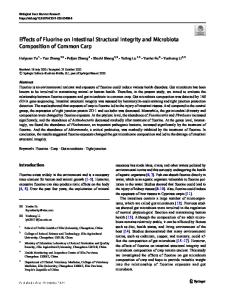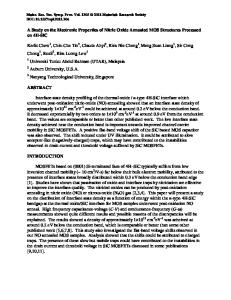Effects of Fluorine on MOS Properties
- PDF / 453,768 Bytes
- 10 Pages / 420.48 x 639 pts Page_size
- 71 Downloads / 401 Views
EFFECTS OF FLUORINE ON MOS PROPERTIES T. P. Ma Yale University Center for Microelectronic Materials & Structures, and Department of Electrical Engineering New Haven, Connecticut 06520, USA
ABSTRACT The incorporation of small amounts of fluorine has been found to improve the properties of MOS devices. In this paper, some of these results will be reviewed, several techniques to introduce fluorine will be described, the distributions of F resulting from these processes will be shown, and the possible mechanisms leading to the improved MOS device reliability will be discussed.
I. INTRODUCTION Gases containing chlorine are widely used in furnace tube cleaning and gate oxide formation. The benefits that have been reported include passivation of mobile ions [1], enhancement of the carrier lifetimes in Si [2], and improvement of the oxide dielectric breakdown strength [3]. Since the chemical properties of fluorine are in many ways similar to chlorine, one might expect similar benefits from the use of fluorine. Indeed, such benefits have been observed both in our laboratory and elsewhere in the last few years. In addition to the benefits mentioned above, the incorporation of appropriate amounts of F in thermal SiO 2 has been found to improve the reliability of MOS devices. In particular, it increases the radiation hardness of the MOS device and its resistance to hot-carrier damage [4-12]. Several different techniques for introducing F have been reported, including (i) soaking the Si wafer in a HF solution prior to thermal oxidation [4,5], (ii) growing the thermal oxide with parts per million of NF 3 in 02 [4,6], (iii) shallow F implantation into poly-Si gate, followed by heat treatment to diffuse the F into the underlying gate oxide [7-11], and (iv) pre-oxidation F implant into Si, followed by gate oxidation [12]. While the details may vary, the results from these techniques are qualitatively very similar; i.e., an appropriate amount of F gives rise to improved resistance to hot-carrier and radiation damage, while either too little or too much F does not help. Given the fact that the gate oxide reliability depends strongly on the amount and distribution of F, it would be desirable to be able to predict how F moves in the MOS system during wafer processing. Unfortunately, however, the diffusion coefficients of F in SiO 2 and in Si cannot be found in the published literature. Our recent experiment, in collaboration with IBM, showed that F exhibited anomalous diffusion behavior in Si, suggesting that a lot more work is needed before one is able to develop a reasonable model useful for process simulation. The following section will present some representative experimental results related to the effects of F on MOS properties, with an emphasis on the gate oxide reliability.
Mat. Res. Soc. Symp. Proc. Vol. 262. 01992 Materials Research Society
742
II. EFFECTS OF FLUORINE ON GATE OXIDE RELIABILITY At the outset, it is useful to point out that, although some of the results to be presented were obtained from radiation experime
Data Loading...











